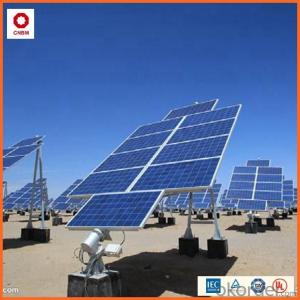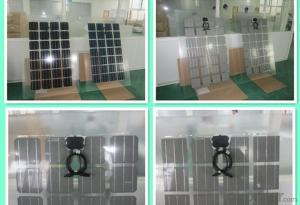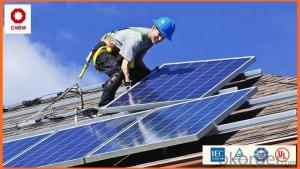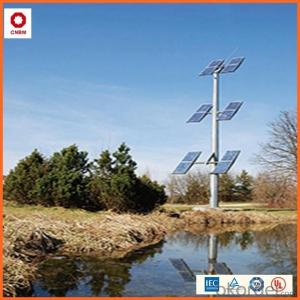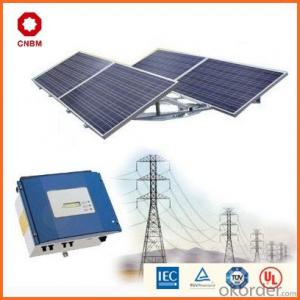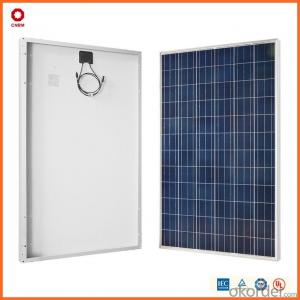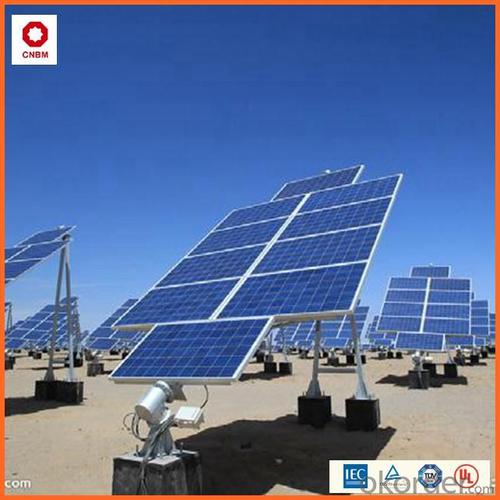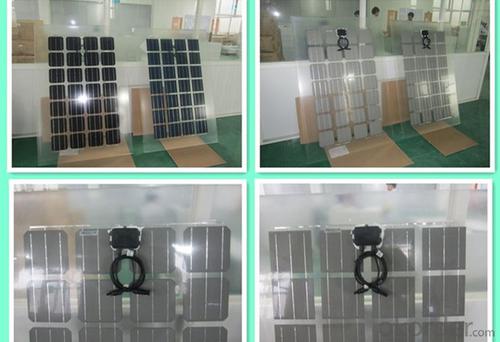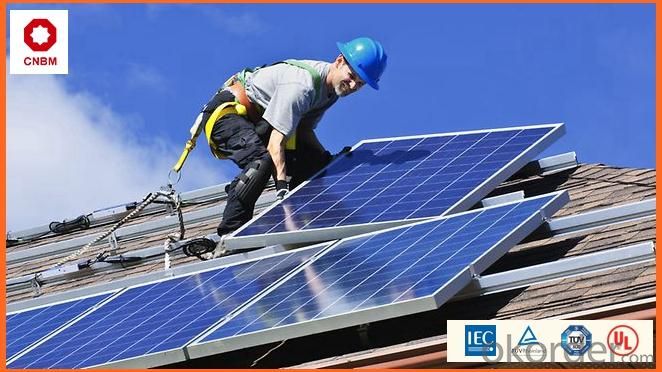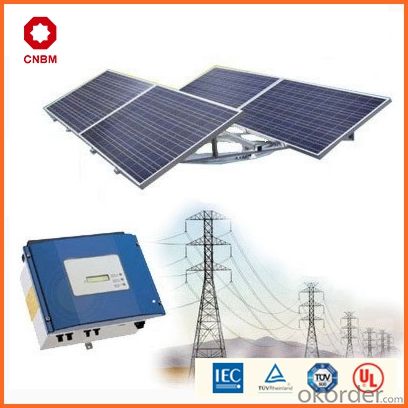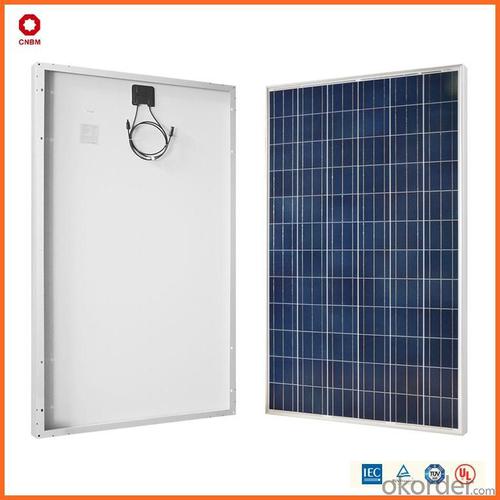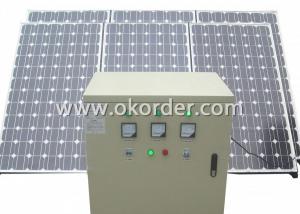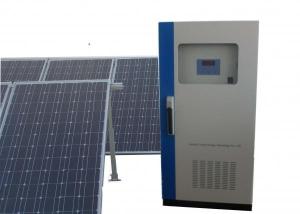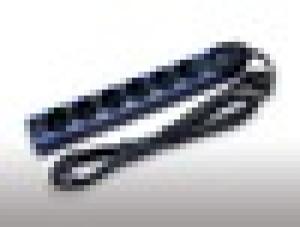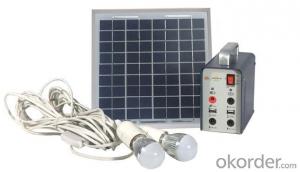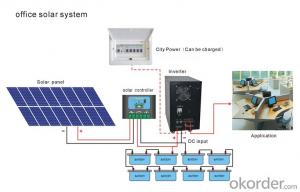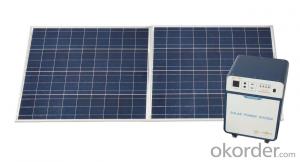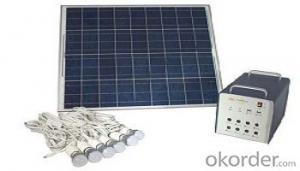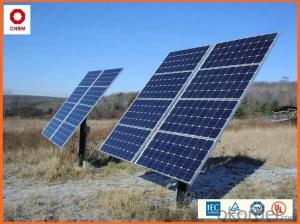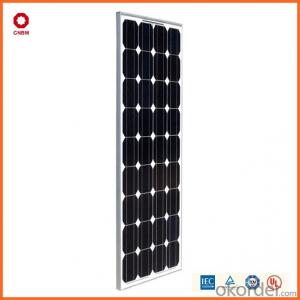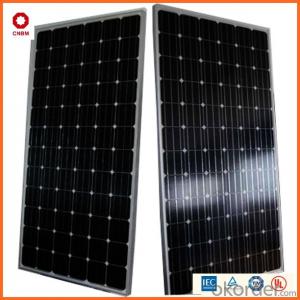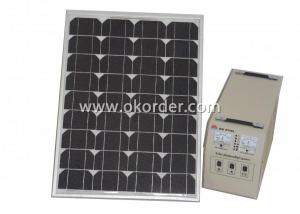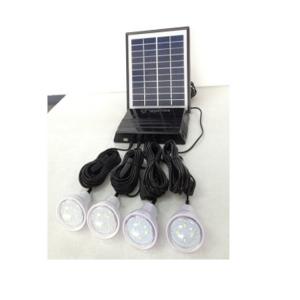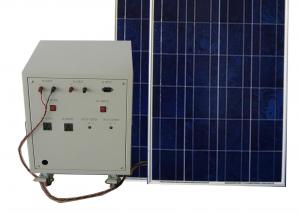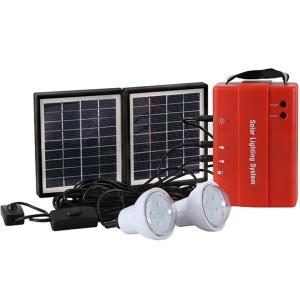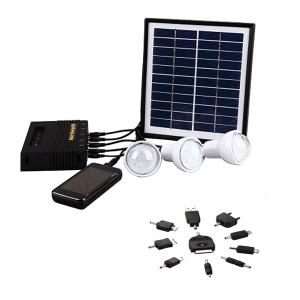70w Small Solar Panels in Stock - Solar Energy Systems Fort Pierce - China Manufacturer
- Loading Port:
- China main port
- Payment Terms:
- TT OR LC
- Min Order Qty:
- 1 watt
- Supply Capability:
- 10000000 watt/month
OKorder Service Pledge
OKorder Financial Service
You Might Also Like
Specification
Product Description:
Hot Sale !!! Quality and Safety of Small Poly Solar Panel 5w~150w
1. Rigorous quality control meets the highest international standards.
2. High-transmissivity low-iron tempered glass, strong aluminium frame.
3. Using UV-resistant silicon.
4. IS09001/14001/CE/TUV/UL
Warranties of Small Poly Solar Panel 35~85w
1. 10 years limited product warranty
2. 15 years at 90% of the minimal rated power output
3. 25 years at 80% of the minimal rated power output
Specification
Characteristics of Poly solar panels CNBM (245-320W) | |||||
Max Power Voltage Vmp(V) | 30.3 | 30.8 | 31.1 | 31.4 | 31.85 |
Max Power Current Imp(A) | 7.60 | 7.64 | 7.73 | 7.81 | 7.85 |
Open Circuit Voltage Voc(V) | 36.1 | 36.6 | 37 | 37.3 | 37.68 |
Short Circuit Current Isc(A) | 8.50 | 8.55 | 8.65 | 8.75 | 8.85 |
Max Power Pm(W) | 230W | 235W | 240W | 245W | 250W |
Temperature Coefficient of Cells Poly solar panels CNBM (245-320W) | |
NOCT | 45± 2 |
Temperature Coeffucients of Isc | 0.0492 |
Temperature Coeffucients of Voc | -0.3374 |
Temperature Coeffucients of Voc | -0.4677 |
Mechanical Data of Poly solar panels CNBM (245-320W) | |
Dimension | 1638 × 982 × 40 mm |
Weight | 19.5 kg |
No. of Cells and Connections | 60 (6 ×10) |
Tolerance | 0 ~ + 5 W |
Cell | Monocrystalline Cell 156 × 156 mm |
Packing | 624 Pcs/40ft(H) Container |
Limits of Poly solar panels CNBM (245-320W) | |
Operating Temperature | -40 to +85 |
Storage Temperature | -40 to +85 |
Max System Voltage | 1000VDC(IEC) / 600VDC(UL) |
Features of our products:
• High conversion efficiency mono/poly-crystalline amorphous silicon solar cells
• Modules incorporate high performance bypass diodes to minimize the power drop caused by shading
• High transmittance, low-iron tempered glass
• High performance EVA encapsulant to prevent destroying and water.
• AI frame: without screw, corner connection. 8 holes on the frame can be installed easily
• Good performance of preventing from atrocious weather such as wind and hails
• Certifications: CE IEC TUV VDE UL, Class I
• 10 years 90% power output warranty
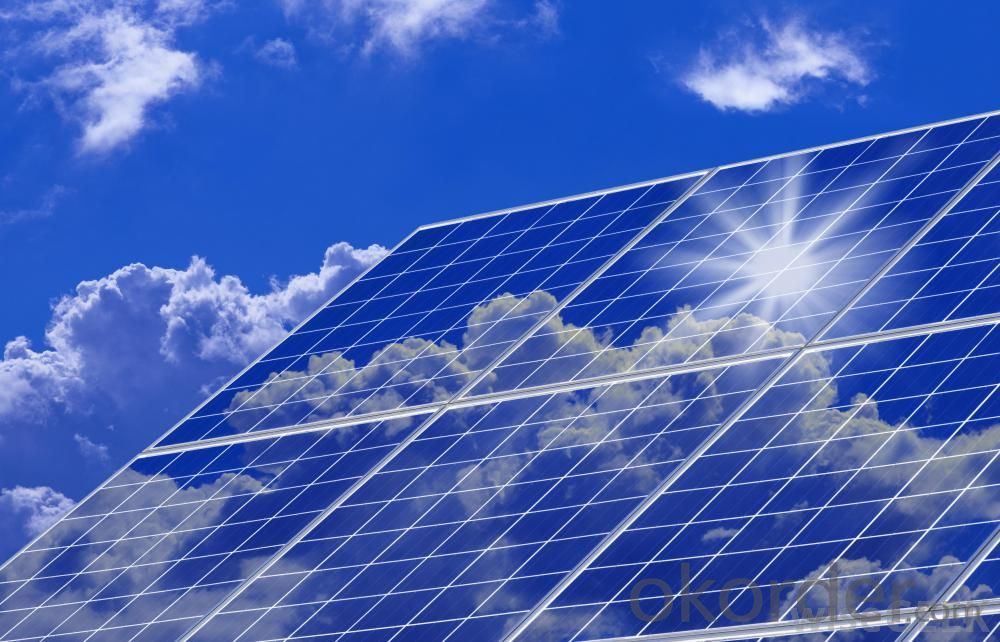
Shipping of Small Poly Solar Panel 35~85w
By Sea | Delivery from Shanghai or Ningbo seaport |
By Air | Departure from Shanghai Pudong Airport |
By Express | Post by DHL, EMS, UPS, TNT. |
Features of our products:
• High conversion efficiency mono/poly-crystalline amorphous silicon solar cells
• Modules incorporate high performance bypass diodes to minimize the power drop caused by shading
• High transmittance, low-iron tempered glass
• High performance EVA encapsulant to prevent destroying and water.
• AI frame: without screw, corner connection. 8 holes on the frame can be installed easily
• Good performance of preventing from atrocious weather such as wind and hails
• Certifications: CE IEC TUV VDE UL, Class I
• 10 years 90% power output warranty
As a professional Solar Panel manufacturer and Supplier in China, we have our customers come around the whole world and our specialization has got a worldwide recognition. Meanwhile, with our superior quality, competitive price, prompt and excellent service, As main role in trade section of CNBM Group, CNBM International Corporation supplies products including Monocrystalline Solar Panel, Polycrystalline Solar Panel ( multicrystalline silicon Solar Panel) have received and enjoyed famous reputation in many countries and regions in the world.
- Q: What are the different types of solar energy systems?
- The different types of solar energy systems include solar photovoltaic (PV) systems, solar thermal systems, concentrated solar power (CSP) systems, and hybrid solar systems.
- Q: Can solar energy systems be used in areas with limited access to solar grounding equipment?
- Yes, solar energy systems can still be used in areas with limited access to solar grounding equipment. While proper grounding is important for safety and system performance, there are alternative methods available that can be used in such areas. These methods may involve using specialized mounting systems, such as pole-mounted or ballasted systems, or utilizing ground-mount systems that do not require extensive grounding equipment. It is essential to consult with solar energy professionals or engineers to determine the most suitable and safe approach for installing solar energy systems in these situations.
- Q: Can solar energy systems be used for water desalination?
- Yes, solar energy systems can be used for water desalination. Solar-powered desalination systems use solar energy to power the desalination process, which removes salt and other impurities from seawater or brackish water to make it suitable for drinking or irrigation purposes. These systems typically utilize solar panels to convert sunlight into electricity, which is then used to power the desalination process, such as reverse osmosis or distillation. By harnessing the renewable energy of the sun, solar-powered desalination offers a sustainable and environmentally friendly solution to address water scarcity issues in coastal regions.
- Q: Can solar energy systems be used for powering wastewater or sewage treatment plants?
- Yes, solar energy systems can be used for powering wastewater or sewage treatment plants. Solar energy can be harnessed through the use of solar panels or solar thermal systems to generate electricity or heat, which can then be used to power various processes in these treatment plants. Solar panels convert sunlight into electricity using photovoltaic cells, which can be installed on the rooftops or open fields near the treatment plants. This electricity can be used to power pumps, blowers, and other equipment required for the treatment process. By using solar energy, these plants can significantly reduce their reliance on traditional grid electricity, leading to cost savings and a reduced carbon footprint. Solar thermal systems, on the other hand, use the sun's heat to generate hot water or steam. This heat can be utilized in the treatment process, such as for heating up water or sludge, which is essential for effective treatment. Solar thermal systems can be integrated into the existing infrastructure of the treatment plants, providing a sustainable and renewable source of thermal energy. In addition to reducing operational costs and environmental impact, solar energy systems also offer the advantage of being decentralized and independent from the grid. This means that even in remote areas or during power outages, the wastewater or sewage treatment plants can continue to operate efficiently. Overall, the use of solar energy systems for powering wastewater or sewage treatment plants is a viable and sustainable solution that can contribute to a cleaner and more energy-efficient water management system.
- Q: What is the impact of tree shade on the performance of solar panels?
- The impact of tree shade on the performance of solar panels is significant. When solar panels are shaded by trees, it significantly reduces their electricity generation capacity. Tree shade blocks the sunlight that is necessary for the panels to convert into electricity, thus diminishing their efficiency. As a result, shaded solar panels may produce less power or even stop generating electricity altogether. It is crucial to ensure that solar panels are installed in areas with minimal shade to maximize their performance and optimize energy production.
- Q: Can solar energy systems be used for powering electric vehicle sharing programs?
- Yes, solar energy systems can be used to power electric vehicle sharing programs. Solar energy is a renewable and sustainable source of power, making it an ideal solution for reducing carbon emissions and promoting clean transportation. By installing solar panels and utilizing the energy they produce, electric vehicle sharing programs can operate on clean and green energy. This eliminates the reliance on fossil fuels and reduces the overall environmental impact of the program. Additionally, solar energy systems can provide a reliable and cost-effective source of power for charging electric vehicles, making it an efficient and practical solution for powering these programs.
- Q: What are the different financing models for installing solar energy systems?
- Installing solar energy systems offers various financing models to cater to individual preferences and financial capabilities. Here are some commonly used financing options: 1. Complete Purchase: The most direct approach is to outright purchase the solar energy system. Although it requires a significant upfront investment, it grants the homeowner or business owner full access to the benefits and incentives associated with solar energy, such as tax credits and reduced utility bills. 2. Solar Loans: Many financial institutions provide specialized loans for solar installations, offering lower interest rates and longer repayment terms compared to conventional loans. With a solar loan, the system owner makes monthly payments to the lender while enjoying the financial advantages of lower utility bills and potential tax credits. 3. Power Purchase Agreements (PPAs): A PPA involves a contract between the solar system owner and a third-party solar provider. Under this agreement, the solar provider installs and maintains the system on the customer's property, and the customer agrees to purchase the electricity generated by the system at a predetermined rate. This eliminates the need for upfront costs and allows immediate savings on the electricity bill. 4. Solar Leases: Similar to PPAs, solar leases involve a third-party solar provider installing and maintaining the system. However, instead of purchasing the electricity, the customer pays a fixed monthly lease payment for the use of the solar energy system. While this option may not provide as much savings as other financing models, it requires minimal upfront investment. 5. Property Assessed Clean Energy (PACE) Financing: PACE financing enables property owners to finance the installation of solar energy systems through an assessment on their property tax bill. The loan is repaid over a period of time, typically 10 to 20 years, through an additional assessment on the property taxes. PACE financing is particularly advantageous for property owners who may not qualify for traditional loans or prefer to spread out the cost of the solar installation over a longer duration. These examples highlight the different financing models available for installing solar energy systems. It is crucial to carefully evaluate each option, considering factors such as upfront costs, long-term savings, and individual financial goals, to determine the most suitable financing arrangement for specific circumstances.
- Q: What is the role of trackers in solar energy systems?
- Trackers in solar energy systems are responsible for increasing the efficiency and performance of solar panels by aligning them with the sun's position throughout the day. These devices track the sun's movement and adjust the angle and position of the panels to maximize the amount of sunlight they receive, ultimately generating more electricity and increasing the overall energy output of the system.
- Q: Can solar energy systems be used in areas with high levels of bird activity?
- Solar energy systems can indeed be used in areas where there are many birds. However, it is crucial to take precautions in order to ensure the safety of the birds and the optimal performance of the solar panels. A common concern is the possibility of birds colliding with the panels. To address this, manufacturers often include bird deterrents such as mesh screens or reflective coatings on the panels, which make them more visible to birds and decrease the risk of collisions. Additionally, proper installation and maintenance of the solar energy systems can minimize potential nesting or roosting sites for birds, thus reducing the likelihood of damage to the panels. By addressing these considerations, it is possible to effectively utilize solar energy systems in areas with high bird activity while still protecting the local bird population.
- Q: How much does a solar energy system cost?
- The cost of a solar energy system can vary depending on various factors such as the size of the system, the location, and any additional equipment or services required. On average, a residential solar energy system can range from $10,000 to $30,000, but it is recommended to consult with a solar installer to get a more accurate cost estimate based on specific requirements.
Send your message to us
70w Small Solar Panels in Stock - Solar Energy Systems Fort Pierce - China Manufacturer
- Loading Port:
- China main port
- Payment Terms:
- TT OR LC
- Min Order Qty:
- 1 watt
- Supply Capability:
- 10000000 watt/month
OKorder Service Pledge
OKorder Financial Service
Similar products
Hot products
Hot Searches
Related keywords
